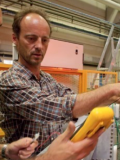Bruno Guérard

Bruno Guérard
Bruno Guérard of the Institut Laue Langevin (ILL), is the Head of ILL's detector group. He is also responsible for ILL participation in task 4.3 that focuses in the development of large area detectors. Bruno participated in the development of neutron gas detectors (2 patents) in several European Projects and introduced and developed the Multi-Grid and Multi-Blade concept. The Multi-Grid detector is an important technology for future large area detectors.
What is your role in BrightnESS?
ILL is involved in task T4.3 (Large area detectors) managed by Anton Khaplanov in the work package WP4. As head of the ILL detector group, I am managing the ILL participation in task T4.3.
Could you describe one of your typical workdays?
I have currently 2 activities related to BrightnESS: I am dealing with the recruitment of a post-doc (we have just made a preselection of the candidates for interviews), and I am managing the work of a draftsman with whom I am studying the design of a new MultiGrid prototype with enhanced performances. The new design (compared to the CRISP design) better exploits the capacity of ESS for the production of B4C films by using larger substrates. Furthermore, we plan to increase the number of B4C films from 34 to 48 while keeping the same volume of detection, and the detector will be operated with a low pressure of the detection gas to reduce dead zones and mechanical constraints for operation in vacuum.
What do you like the most about the BrightnESS project?
There is one important difference compared to previous european projects : in BrightnESS, we expect a high impact of our future results on the quality of the instruments of ESS. This brings additional pressure and motivation to develop new detectors.
What are for you, personally, the key challenges within the BrightnESS project?
There are a lot of technical challenges in BrightnESS, in particular to develop fast detectors than can sustain long term operation in a harsh radiation environment. Detectors must be also at least an order of magnitude faster and more precise than nowadays technologies. Besides technical challenges, another challenge will be to make decisions on detector techniques to be supported in priority for the first instruments of ESS. If "development A" fails to fulfill the requirements, then a "development B" with a reduced risk must be decided at the right moment to ensure the operability of the instrument even at the cost of reduced performances. The balance between resources and technical risk with strong time constraints, and high performance expectation is a big challenge.

 is funded by the European Union Framework Programme for Research and Innovation Horizon 2020, under grant agreement 676548.
is funded by the European Union Framework Programme for Research and Innovation Horizon 2020, under grant agreement 676548.